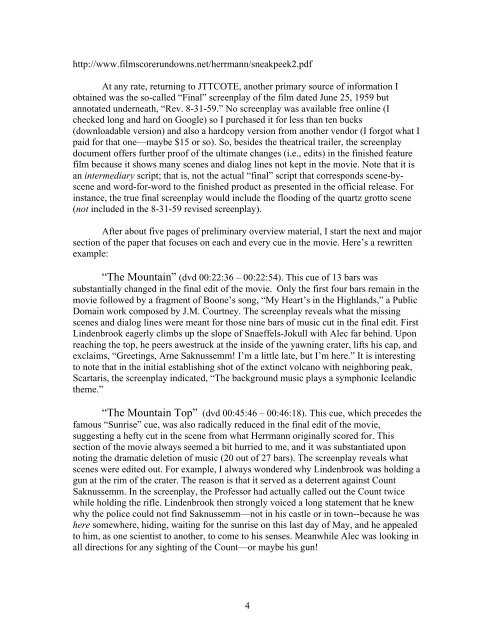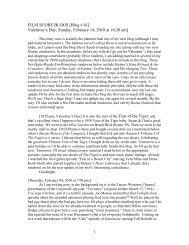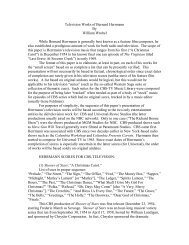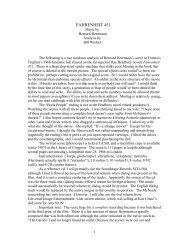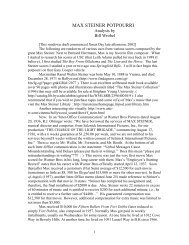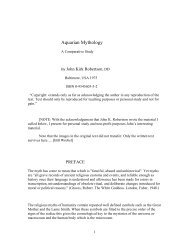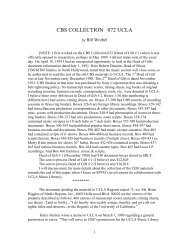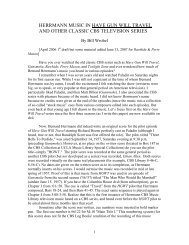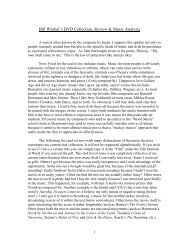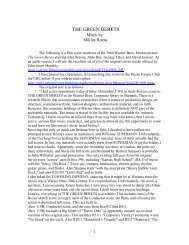The Deleted Music & Scenes from Journey to the Center of the Earth
The Deleted Music & Scenes from Journey to the Center of the Earth
The Deleted Music & Scenes from Journey to the Center of the Earth
You also want an ePaper? Increase the reach of your titles
YUMPU automatically turns print PDFs into web optimized ePapers that Google loves.
http://www.filmscorerundowns.net/herrmann/sneakpeek2.pdf<br />
At any rate, returning <strong>to</strong> JTTCOTE, ano<strong>the</strong>r primary source <strong>of</strong> information I<br />
obtained was <strong>the</strong> so-called “Final” screenplay <strong>of</strong> <strong>the</strong> film dated June 25, 1959 but<br />
annotated underneath, “Rev. 8-31-59.” No screenplay was available free online (I<br />
checked long and hard on Google) so I purchased it for less than ten bucks<br />
(downloadable version) and also a hardcopy version <strong>from</strong> ano<strong>the</strong>r vendor (I forgot what I<br />
paid for that one—maybe $15 or so). So, besides <strong>the</strong> <strong>the</strong>atrical trailer, <strong>the</strong> screenplay<br />
document <strong>of</strong>fers fur<strong>the</strong>r pro<strong>of</strong> <strong>of</strong> <strong>the</strong> ultimate changes (i.e., edits) in <strong>the</strong> finished feature<br />
film because it shows many scenes and dialog lines not kept in <strong>the</strong> movie. Note that it is<br />
an intermediary script; that is, not <strong>the</strong> actual “final” script that corresponds scene-byscene<br />
and word-for-word <strong>to</strong> <strong>the</strong> finished product as presented in <strong>the</strong> <strong>of</strong>ficial release. For<br />
instance, <strong>the</strong> true final screenplay would include <strong>the</strong> flooding <strong>of</strong> <strong>the</strong> quartz grot<strong>to</strong> scene<br />
(not included in <strong>the</strong> 8-31-59 revised screenplay).<br />
After about five pages <strong>of</strong> preliminary overview material, I start <strong>the</strong> next and major<br />
section <strong>of</strong> <strong>the</strong> paper that focuses on each and every cue in <strong>the</strong> movie. Here’s a rewritten<br />
example:<br />
“<strong>The</strong> Mountain” (dvd 00:22:36 – 00:22:54). This cue <strong>of</strong> 13 bars was<br />
substantially changed in <strong>the</strong> final edit <strong>of</strong> <strong>the</strong> movie. Only <strong>the</strong> first four bars remain in <strong>the</strong><br />
movie followed by a fragment <strong>of</strong> Boone’s song, “My Heart’s in <strong>the</strong> Highlands,” a Public<br />
Domain work composed by J.M. Courtney. <strong>The</strong> screenplay reveals what <strong>the</strong> missing<br />
scenes and dialog lines were meant for those nine bars <strong>of</strong> music cut in <strong>the</strong> final edit. First<br />
Lindenbrook eagerly climbs up <strong>the</strong> slope <strong>of</strong> Snaeffels-Jokull with Alec far behind. Upon<br />
reaching <strong>the</strong> <strong>to</strong>p, he peers awestruck at <strong>the</strong> inside <strong>of</strong> <strong>the</strong> yawning crater, lifts his cap, and<br />
exclaims, “Greetings, Arne Saknussemm! I’m a little late, but I’m here.” It is interesting<br />
<strong>to</strong> note that in <strong>the</strong> initial establishing shot <strong>of</strong> <strong>the</strong> extinct volcano with neighboring peak,<br />
Scartaris, <strong>the</strong> screenplay indicated, “<strong>The</strong> background music plays a symphonic Icelandic<br />
<strong>the</strong>me.”<br />
“<strong>The</strong> Mountain Top” (dvd 00:45:46 – 00:46:18). This cue, which precedes <strong>the</strong><br />
famous “Sunrise” cue, was also radically reduced in <strong>the</strong> final edit <strong>of</strong> <strong>the</strong> movie,<br />
suggesting a hefty cut in <strong>the</strong> scene <strong>from</strong> what Herrmann originally scored for. This<br />
section <strong>of</strong> <strong>the</strong> movie always seemed a bit hurried <strong>to</strong> me, and it was substantiated upon<br />
noting <strong>the</strong> dramatic deletion <strong>of</strong> music (20 out <strong>of</strong> 27 bars). <strong>The</strong> screenplay reveals what<br />
scenes were edited out. For example, I always wondered why Lindenbrook was holding a<br />
gun at <strong>the</strong> rim <strong>of</strong> <strong>the</strong> crater. <strong>The</strong> reason is that it served as a deterrent against Count<br />
Saknussemm. In <strong>the</strong> screenplay, <strong>the</strong> Pr<strong>of</strong>essor had actually called out <strong>the</strong> Count twice<br />
while holding <strong>the</strong> rifle. Lindenbrook <strong>the</strong>n strongly voiced a long statement that he knew<br />
why <strong>the</strong> police could not find Saknussemm—not in his castle or in <strong>to</strong>wn--because he was<br />
here somewhere, hiding, waiting for <strong>the</strong> sunrise on this last day <strong>of</strong> May, and he appealed<br />
<strong>to</strong> him, as one scientist <strong>to</strong> ano<strong>the</strong>r, <strong>to</strong> come <strong>to</strong> his senses. Meanwhile Alec was looking in<br />
all directions for any sighting <strong>of</strong> <strong>the</strong> Count—or maybe his gun!<br />
4


